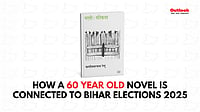Nuclear weapons are irrelevant for these real threats to India's security; the large-scale conventional and nuclear conflicts Kalam wants to deter with nuclear weapons belong to a bygone age. But his mindset reflects that of the defence and nuclear scientists, and it is their story that Chengappa tells us. As he admits: "This book will provide never before published insights into the minds of those who were involved both in the decision-making process and in the building of the bomb. It is a compelling narrative and I have written the book in a style that demystifies the subject..."
Some of these insights are truly astonishing. Apparently two atomic devices were lowered into their shafts in May 1996, during the first 13-day Vajpayee government's term in office; Vajpayee's famous letter to Clinton designating China as India's major nuclear threat was intended to divide American opinion and ally India with anti-China lobbies in the US. An air-deliverable atomic bomb was successfully test-flown with a Mirage-2000 aircraft in May 1994; the then prime minister Rao never ordered nuclear tests to be conducted in December 1995-they are believed to have been aborted under American pressure; the Agni-II missile test-fired in April 1999 carried a mocked-up warhead minus the nuclear core; and India had readied its nuclear weapons during the Kargil conflict, as had Pakistan.
The book is pure reportage, and Chengappa's "demystifying style" is pure journalese. We are informed that (Brajesh) Mishra "literally dived to pick up the (telephone) receiver"; Vajpayee possesses a "granite calm"; George Fernandes' "grey hair flowed with the usual abandon across his pate". And "overweight Jayalalitha", "bony Mamata", "owl-eyed Sikka" round out the cast. This plenitude of adjectives affects the seriousness of the book.
At times Chengappa is being inventive. Reportedly Vajpayee "looked delighted" when informed that India had acquired thermonuclear capabilities, but looked "fazed" when the technical details were explained. But there are moments of inspired prose, viz: "Peninsular India droops down like a flaccid penis from the underbelly of the Asian continent." India corrects that by acquiring nuclear weapons and ballistic missiles establishing, yet again, the symbiotic link between weapons and sex.
Since this "compelling narrative" is mostly based on interviews, there could be some doubts about its accuracy. Memory has a way of playing tricks with recollecting facts and chronologies; personal biases and prejudices do colour the account; and there is a noticeable tendency among participants in great events to exaggerate one's own role.
Still, this narrative of India's nuclear and missile programmes from their inception to the present is important. It brings out the human aspects of the story and the interplay between the major participants involved, and therefore makes for an interesting and easy read.

























